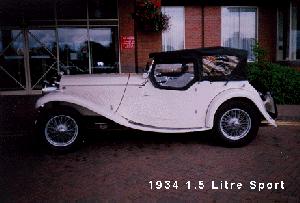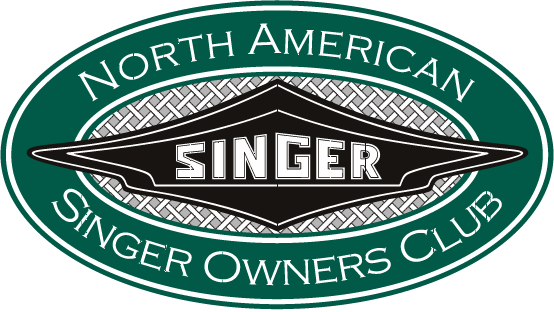1.5 Sports
1933 saw the introduction of the 1.5 Litre Sports which looked very much like its contemporary, the Lagonda M45 Tourer. Although based on the Nine Sports design, it was a larger car, sitting on a lowered version of the chassis developed for the Singer Fourteen Saloon, allowing for a roomier and more imposing body with more flowing lines. The larger size necessitated an upgrade to the braking system as well. Accordingly, the 1.5 Litre was fitted with 13 inch Lockheed hydraulic brakes, rather than the smaller 10 inch version which were standard on the Nine Sports and Le Mans models. Tires too, were larger than its Nine counterpart, being fitted with 18 X 5.25 inch Dunlops. The familiar Rudge knock – off hubs were also a feature.
 As with the chassis, the six cylinder, 1493 cc overhead cam engine was borrowed from the Fourteen Saloon, although in a slightly altered form. The camshaft was modified so as to give more suitable timing for the high speed performance demands of a sports car and the bore and stroke were reduced to 59 X 91 mm. The engine was fueled by twin Solex horizontal carburetors.
As with the chassis, the six cylinder, 1493 cc overhead cam engine was borrowed from the Fourteen Saloon, although in a slightly altered form. The camshaft was modified so as to give more suitable timing for the high speed performance demands of a sports car and the bore and stroke were reduced to 59 X 91 mm. The engine was fueled by twin Solex horizontal carburetors.
Priced at 295 pounds, the 1.5 Litre Sports provided great value as a lively, yet well mannered car, content at being driven comfortably at cruising speeds of 60 -70 m.p.h.
The 1.5 Litre Sports was available in 1933 and 1934, and then re-introduced in 1937 with a number of modifications. The most outwardly visible were the fitting of 17 X 5.25 inch tires, twin mounted spares on the rear of the car and a generally more sweeping look.
Although also a 1.5 Litre, the engine differed substantially from that used in the 1933-34 models in that its capacity of 1496 cc.’s was not derived from six cylinders, but from a four cylinder engine with a bore and stroke of 68 X 103 mm. The engine developed 59 b.h.p. at 5000 r.p.m. and had a performance throughout the speed range which exceeded that of the 1.5 Litre sixes which had done so well in competition.
An interesting new feature was the addition of the Lockheed “hill holder”. This was particularly useful in restarting tests as it was designed to hold the loading on all four brakes if the clutch pedal was depressed after the car had been brought to a complete stop with the brake pedal. Upon transferring the right foot to the accelerator, as the clutch was engaged for a getaway, the brakes released simultaneously. This device would function only if the car was on an upward gradient. The 1937 1.5 Litre Sports was offered at a price of 259 pounds.
1.5 Sports Specs
Engine
Six cylinder, 59 mm. by 91 mm. = 1493 c.c.
Treasury rating, 12.95 h.p.; tax 13 pounds
Valves operated by chain driven overhead camshaft
Alloy pistons
Coil ignition with automatic spark advance
Twin Solex carburators
Fan assisted cooling
Vibro damping engine mountings
Gearbox and Transmission
Four speeds with ratios 5.22, 6.65, 10.68 and 19.43 to 1and 26.4:1 reverse
Silent second and third gears
Remote control shift lever
Single dry plate clutch
Open propeller shaft with Hardy Spicer mechanical universal joints
Spiral bevel rear axle
Wheels and Brakes
18 inch Rudge-Whitworth knock on wheels
5.25 X 18 inch tires
Four wheel Lockheed hydraulic brakes, 13 inch drums
General
12 volt lighting and starting system
Wheelbase 9 ft. 1/2 ins. with 7.5 inch ground clearance
Price
295 pounds
